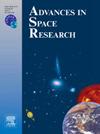Efficient approach of painting asteroids for planetary defense using network data envelopment analysis
IF 2.8
3区 地球科学
Q2 ASTRONOMY & ASTROPHYSICS
引用次数: 0
Abstract
The potential dangers of asteroids hitting the Earth are one of the challenges for mankind to preserve the human species. Various missions have been proposed to defend asteroids. Changing the Albedo magnitude by painting asteroids is a suitable and low-cost idea for the asteroid defense plan. Moving away from the Earth requires fuel consumption and the limitations of carrying the necessary materials for painting. Due to these limitations, we are not able to paint the entire asteroid, or for other reasons, we have to paint parts of the asteroid. Therefore, we should find a relative compromise between the variables to get most efficiency from painting parts of the asteroid. In this paper, we present a network structure of Data Envelopment Analysis (DEA) and consider the relationships of all variables including physical and orbital characteristics, spacecraft limitations, effective solar mass, albedo change rate, and elapsed time of the mission. We look for parts of the asteroid’s surface where we can get the most displacement by spending the least amount of raw material. One of the advantages of the proposed method is the capability of sensitivity analysis to any of the variables affecting the magnitude of the final displacement. The theorems related to the stability were proven analytically, and we show how to reduce the elapsed time by maintaining efficiency in asteroid painting. The performance of the proposed model was analyzed using real and hypothetical data from asteroid Apophis 99942.
求助全文
约1分钟内获得全文
求助全文
来源期刊

Advances in Space Research
地学天文-地球科学综合
CiteScore
5.20
自引率
11.50%
发文量
800
审稿时长
5.8 months
期刊介绍:
The COSPAR publication Advances in Space Research (ASR) is an open journal covering all areas of space research including: space studies of the Earth''s surface, meteorology, climate, the Earth-Moon system, planets and small bodies of the solar system, upper atmospheres, ionospheres and magnetospheres of the Earth and planets including reference atmospheres, space plasmas in the solar system, astrophysics from space, materials sciences in space, fundamental physics in space, space debris, space weather, Earth observations of space phenomena, etc.
NB: Please note that manuscripts related to life sciences as related to space are no more accepted for submission to Advances in Space Research. Such manuscripts should now be submitted to the new COSPAR Journal Life Sciences in Space Research (LSSR).
All submissions are reviewed by two scientists in the field. COSPAR is an interdisciplinary scientific organization concerned with the progress of space research on an international scale. Operating under the rules of ICSU, COSPAR ignores political considerations and considers all questions solely from the scientific viewpoint.
 求助内容:
求助内容: 应助结果提醒方式:
应助结果提醒方式:


